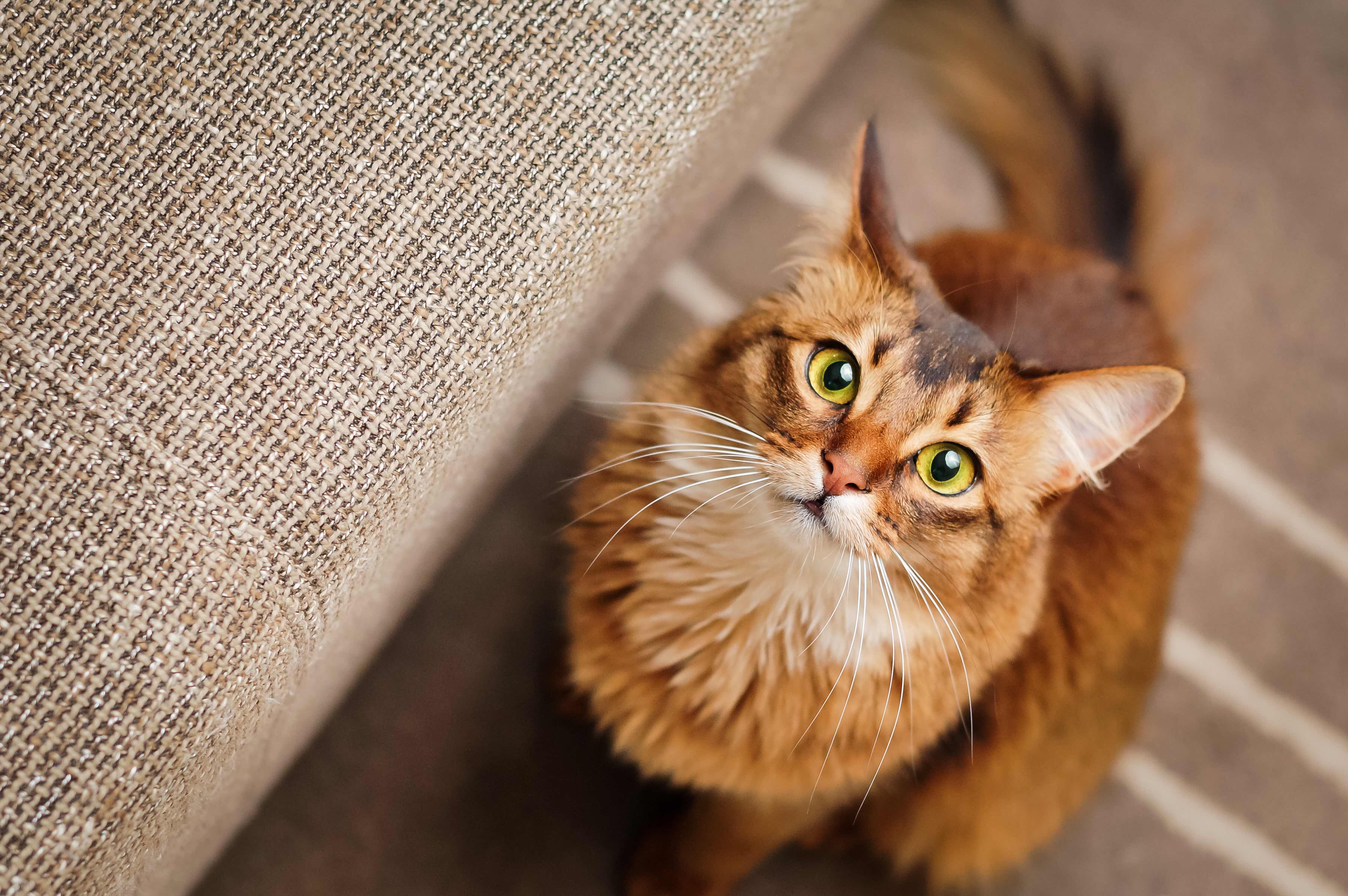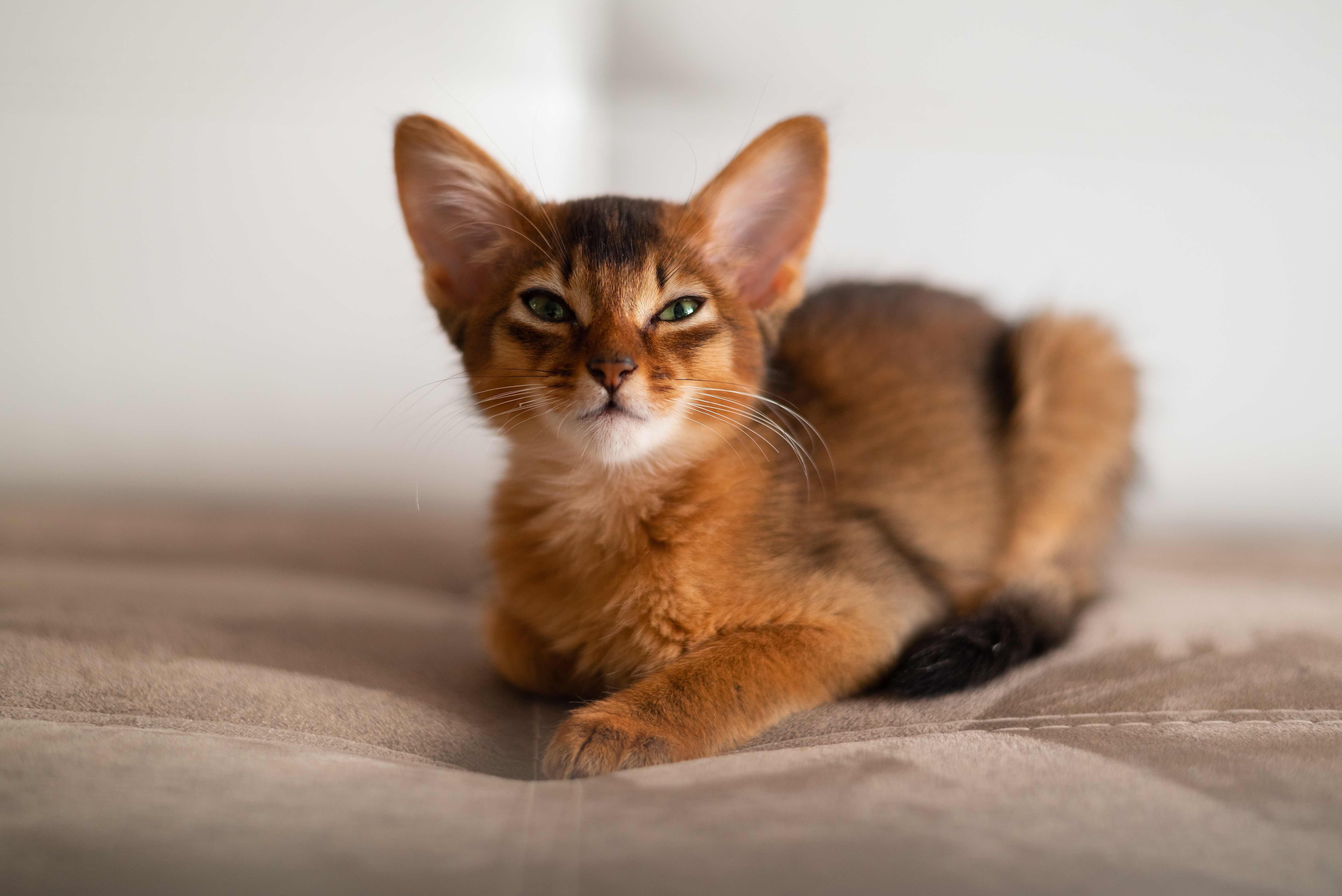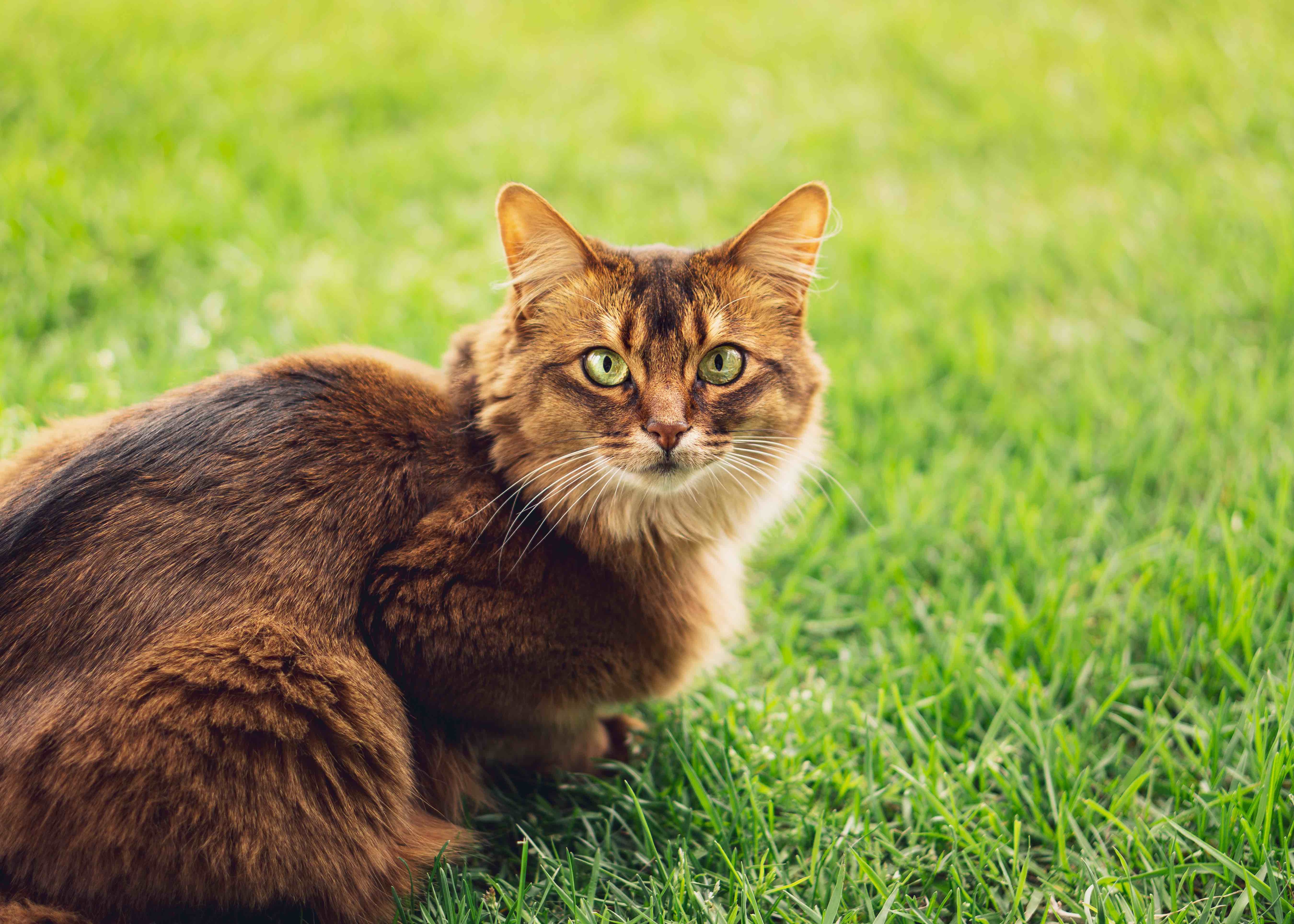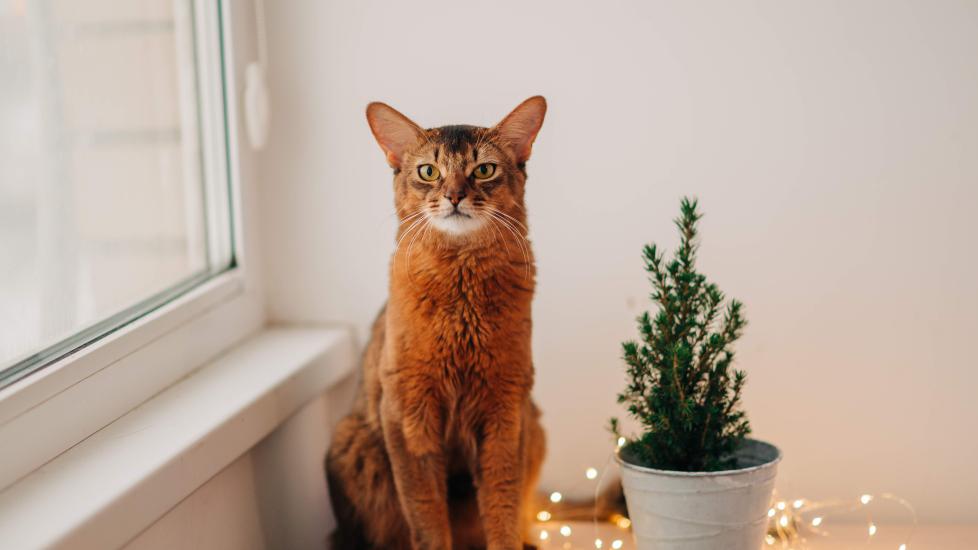Somali
Adobe Stock/Olga Krivokoneva
The Somali cat is lean, compact, athletic, and graceful. But perhaps this cat breed’s biggest draw is her personality.
As clever and curious as she is social and playful, this stunning, long-haired feline makes an entertaining and loving addition to any family—as long as the family provides plenty of mental and physical stimulation, because this kitty doesn’t like to be bored.
The Somali cat breed was first known in Australian cat shows as a long-haired Abyssinian in 1965, and their striking ticked coats can be ruddy (red), cinnamon, blue, fawn, chocolate, or lilac, according to The International Cat Association (TICA). While there are other Somali cat colors, including tortoiseshell, those are uncommon and not officially recognized.
Somalis are relatively small cats, standing 7–11 inches tall and weighing 6–10 pounds.
Caring for a Somali Cat
Dana Tashjian, VMD, is a veterinarian in Sarasota, Florida. She has two Somalis and is very familiar with Somali cat characteristics.
“They’re very social—sometimes almost annoyingly so,” she says. “They’re always around, and they’re very high-energy. They like people, and they’re definitely going to be a part of your life and your family.”
That said, Somalis aren’t typically lap cats and don’t usually like to be held, though they do like to be right next to their people. It's also not uncommon for Somalis to enjoy hanging out on your shoulder. “They just like to know what you’re doing at all times—but on their terms,” Tashjian says.
Their long, silky coat and bushy, foxlike tail are not especially prone to tangling or matting, but pet parents should still brush them once a week (and be ready with the vacuum—especially in the summer, when shedding tends to pick up). This can make them a great choice for someone who loves long-haired cats but doesn’t want the demanding grooming requirements of, say, a Persian.
Somali Cat Health Issues

Somalis are a relatively healthy breed with an expected lifespan of 11–16 years.
As with any cat, regular veterinary care is a must, and Somalis can experience any of the typical health problems our feline friends face—such as arthritis, heart disease, kidney issues, and periodontal disease—especially as they age.
Additionally, there are a couple of potential health issues the Somali cat breed can develop, including:
Pyruvate Kinase (PK) Deficiency
Pyruvate kinase (PK) deficiency is a hereditary disease caused by a deficiency in the pyruvate kinase enzyme, which is essential for the metabolism of red blood cells. A deficiency in this enzyme can lead to anemia and other blood-related problems, which can potentially shorten your cat’s lifespan.
Talk to your Somali cat breeder about whether they’ve genetically tested the parents of any kitten you’re considering bringing home.
Signs of PK deficiency in cats include:
-
Weakness
-
Muscle wasting
-
Jaundice (rare)
-
Pale mucous membranes
-
Elevated heart rate (tachycardia)
-
Inability to perform routine activities
Progressive Retinal Atrophy (PRA)
Progressive retinal atrophy (PRA) is a genetic eye condition that occurs when photoreceptor cells don’t properly develop early on. This typically leads to irreversible blindness within the first few months of a kitten’s life.
There is a basic test breeders should conduct, Tashjian says, so ask your breeder whether either parent is a carrier for PRA. Cats that carry this gene should not be bred. That said, keep in mind that blind kittens and cats can live full, happy lives.
What To Feed a Somali Cat
Feeding your Somali a commercial cat food that meets the nutritional standards set by the Association of American Feed Control Officials (AAFCO) ensures you’re providing your kitty with a complete and balanced diet.
No special diets are typically required unless your veterinarian recommends them. Always select a food that matches your cat’s life stage: kitten, adult, or senior.
How To Feed a Somali Cat
Somalis are very food-motivated and good eaters, Tashjian says. Because of this, measure the amount of food your cat should eat and feed them two meals every day at set times. This prevents overeating and obesity. If your cat eats too quickly, slow her down with a slow-feeder bowl or toy.
How Much Should You Feed a Somali Cat?
Your cat’s age, health, activity level, and ideal weight all factor into her recommended caloric intake. Use the guide on your cat food packaging for a starting point, then discuss your Somali’s food and portions with your veterinarian to make sure you’re keeping her at a healthy weight.
Nutritional Tips for Somali Cats
As long as you provide your Somali with a complete, balanced commercial cat food diet, she should have no trouble getting the nutrition she needs. However, your veterinarian may recommend supplements (such as ones for joint support) to address any health conditions your cat might experience throughout her life.
Behavior and Training Tips for Somali Cats
Somali Cat Personality and Temperament

Inquisitive, intelligent, and energetic, the Somali is a playful cat that needs lots of stimulation to be happy. Tashjian says this breed won’t be satisfied with just a couple of catnip toys.
“You need to play with them regularly to keep them happy,” she says. A Somali cat will also turn anything they find into a toy if the mood suits them, so keep an eye on small items you don’t wish to lose beneath the sofa.
While Somalis are certainly affectionate, Tashjian says that affection comes in whatever way they want to give it. They’re unlikely to enjoy being picked up, but they might love riding around on your shoulders—and they’re athletic enough to get up there easily.
Somali Cat Behavior
Somalis are prone to separation anxiety, so potential pet parents must be prepared to offer plenty of opportunities for play and interaction—with human, feline, and/or cat-friendly canine family members. These cats tend to get along with just about anyone, including respectful children. Because they’re so social, it may be best to bring home two Somali kittens instead of one.
If you intend to leave your Somali at home alone for any period of time, interactive toys, puzzles, scratching posts, and things to climb (such as cat trees and shelves) are a must. A bored Somali is an unhappy Somali, and when a cat with such high intelligence and athleticism is bored, they tend to find ways to entertain themselves—like scratching your furniture.
Somali Cat Training
Somalis are quite clever, so they can pick up on just about anything you care to teach them. Litter box training and getting them on a food schedule is typically a cinch.
“They’re extremely motivated to get what they want, and they have very good memories for the things that they want,” Tashjian says. That can work wonderfully for clicker training with positive reinforcement.
Fun Activities for Somali Cats
-
Fetch
-
Exploring vertical spaces (shelves and cat trees)
-
Being the center of attention
-
Puzzle toys/food puzzles
-
Birdwatching
-
Playing with other pets
-
Riding on shoulders
Somali Cat Grooming Guide
For a cat with such a luxurious coat, the Somali may not be as high-maintenance as you’d think. They don’t shed heavily, but you will still find fur around your house, so regular vacuuming is a must. Occasional grooming, along with the standard nail trims and regular dental care, will keep them looking and feeling their best.
Skin Care
Somalis don’t have sensitive skin and should not require special skin care. Talk to your veterinarian if you notice changes in your cat’s skin or if they are scratching more than usual.
Coat Care
The Somali’s medium-long coat isn’t particularly prone to tangles or mats, but a weekly grooming session is still a good idea. Grooming your cat is also a great bonding opportunity and will decrease shedding.
Eye Care
While you should always watch your cat’s eyes for any unusual changes like redness, irritation, or unusual discharge (all common signs of feline eye problems), no additional special care is needed. Call your veterinarian if you do notice any issues.
Ear Care
Somalis don’t need special ear care. Redness, odor, and/or debris in the ears could be signs of an ear infection or parasites, so checking her ears during your grooming sessions is good practice. If you notice anything unusual, contact your veterinarian.
Considerations for Pet Parents

When well-socialized and with proper introductions, Somalis are social butterflies that love to be around people, other cats, and cat-friendly dogs. Pet parents must be prepared to meet this friendly breed’s social needs—a Somali left alone will quickly become lonely, bored, and unhappy.
Their exercise needs are a consideration, too—this breed will enthusiastically jump, play, explore, and create at least a little chaos. The best home for a Somali provides mental and physical stimulation, and pet families will find the breed’s antics delightful—at least most of the time.
Despite their silky, medium-long coat, the Somali’s grooming needs are not excessive, and they have no other special care requirements, so this breed could be a perfect fit for a well-prepared cat parent.
Somali Cat FAQs
How much do Somali cats cost?
The typical cost of a Somali cat is $1,800–$2,500, according to Mary Franz, a member of The International Cat Association (TICA) Somali breed committee.
A Somali cat price may vary based on what the breeder provides, but beware of a price that seems too good to be true; some disreputable Somali cat breeders do not provide the genetic testing or health guarantees responsible breeders should offer.
Do Somali cats like to be held?
As social as they are, Somali cats do not typically enjoy being held. But they do like to be close to their humans.
What are the Somali cat colors?
Somalis have a striking, ticked coat that can be ruddy, cinnamon, blue, fawn, chocolate, and lilac, with touches of silver.
Are Somali cats from Somalia?
Somali cats are not from Somalia. They are, however, named for Somalia because it borders Ethiopia (formerly Abyssinia). This is a nod to the Somali’s short-haired cousin, the Abyssinian, which is one of the oldest domesticated cat breeds.
